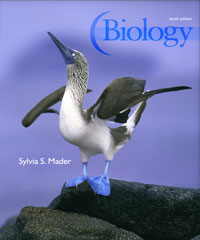Biology (Mader), 10th EditionChapter 21:
Protist Evolution and DiversityLearning OutcomesAfter studying this chapter, you should be able to accomplish the following outcomes.
General Biology of Protists- Describe the general characteristics of protists.
- Summarize the endosymbiotic theory for the origin of the eukaryotic cell.
- Distinguish between algae and protozoans.
Diversity of Protists- Provide the defining characteristics of each of the six eukaryotic supergroups, and list the protists which are assigned to them.
- State the evolutionary relationship between the green algae and land plants.
- Describe conjugation in Spirogyra.
- Summarize the life cycle of Chlamydomonas.
- Give examples of the ecological and economic significance of the different types of algae.
- Identify the two supergroups which include algae.
- Describe the structure of a paramecium, euglenid, amoeboid, and a trypanosome.
- Enumerate the major diseases caused by protists, and name the causative agent of each.
- Summarize the life cycle of Plasmodium vivax.
- Distinguish between plasmodial and cellular slime molds.
- State the evolutionary relationship between choanoflagellates and sponges.
- State the proposed evolutionary relationship between nucleariids and fungi.
Science Focus: Life Cycles Among the Algae- Summarize the three common types of life cycles in sexual reproduction.
 | 




